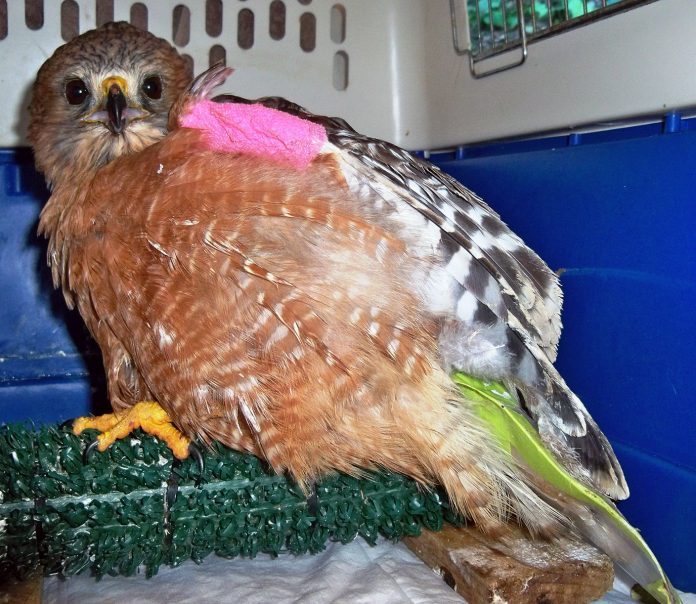New Year’s resolutions abound this time of year. For humans, they often include the usual resolve to quit smoking, lose weight and exercise more.
But wildlife resolutions include: don’t eat poisoned rodents, avoid being window whackers, dodge sneaky cats and keep out of the path of cars—prime causes of injuries to the wild critters that share our world. Animals not fortunate enough to avoid being hurt due to one of these circumstances are sometimes lucky enough to be rescued and brought to a wildlife rehabilitator.
Such is the case of a red-shouldered hawk, which was found in a field in south San Jose not far from a busy expressway. Because of the location, it appeared to be a victim of HBV, a wildlife rehabilitation term meaning “hit by vehicle.”
The rescuer transported the bird to the Wildlife Education and Rehabilitation Center on Christmas morning. At the raptor’s initial examination, staff was able to feel a break in the left wing bone and X-rays proved there was a midshaft fracture of the radius. Compounding the bird’s troubles was possible head trauma and it was emaciated and weak. Treatment began immediately, including daily pain medication and wing wrap for three weeks to stabilize the bones and allow calcification to mend it.
The hawk has been given the name “Noel” in honor of the day of her arrival. She was very hungry and ate voraciously—eight small rodents a day—and in three weeks had gained more than 60 percent of her original weight.
The hawk is now well on the way to full recovery and if her next X-ray shows the bone has completely healed, she will transfer to a larger enclosure to prepare for flight exercise. She is currently wearing a tail sheath to keep her black-and-white-banded tail feathers from cracking and breaking while she is in the small enclosure. Good tail feathers are important for the survival of a wild hawk because they serve as a rudder, helping the hawk to soar, swoop and accurately seize prey. If her feathers were to break, she would need to remain longer in captivity until she molted, possibly until late spring, and we are anxious to return her home.
It is very important the adult female be released back to her original habitat as soon as she is fully recovered so she can hopefully reunite with her mate. Red-shouldered hawks are monogamous and return to the same nesting territory year after year, but a bird will search for a new mate if its partner is killed or missing too long. Breeding occurs once a year, usually between April and July. If all goes as well as we expect, we foresee a mid-February release.
The red-shouldered hawk is a resident of western California (the subspecies is called buteo lineatus elegans, meaning elegant lined soaring hawk) and the eastern United States. In the western parts of its range, the hawk favors oak forests, woods near water and suburban woodlots. The red-shouldered hawk appears to be increasing in some areas, partly due to its ability to adapt so well to urban environments.
In the wild, red-shouldered hawks typically perch patiently on a tree, telephone pole or fence post waiting for a potential meal to come into view and then swoop down on their prey, which consists of a carnivorous cornucopia of nature’s bounty: gophers, mice, moles, voles, rabbits, squirrels, amphibians, reptiles, insects and small birds.
While defending its territories, the hawk makes its presence loud and clear—screaming its characteristic sharp, high-pitched, repetitive ‘kee-yeeer’ call. The aggressive bird-of-prey will attempt to attack any red-shouldered hawk (their diurnal competition) or great horned owl (their main nocturnal predator) that intrudes their habitat. Even humans can attest to the fierceness of hawks during breeding season; hawks have been reported attacking people who come anywhere near their nests. So you can add “stay out of the range of an angry bird” as one of your resolutions to stay healthy.
Knowing we have helped this animal become healthy again so it will survive and prosper in the wild is the best gift that a wildlife rehabilitator could receive. Happy New Year, Noel! And best wishes for many more.
The Wildlife Education and Rehabilitation Center rehabilitates native wildlife and is supported solely by donations from businesses and the public. To contact WERC, call (408) 779-9372 or visit werc-ca.org.










